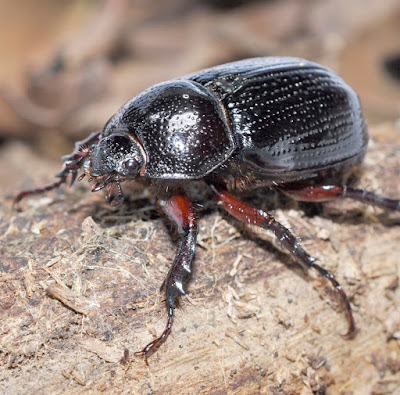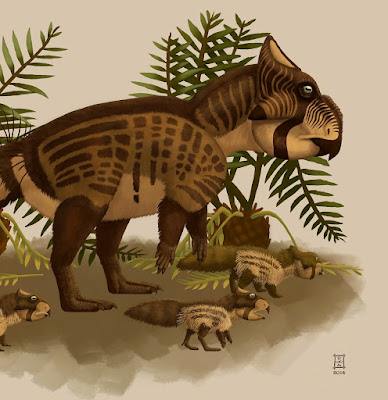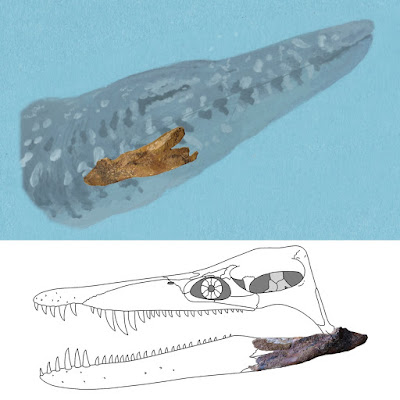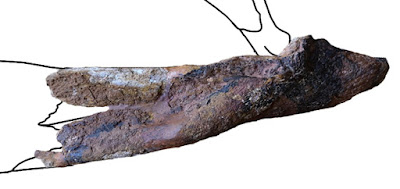[Most Recent Entries] [Calendar View]
Friday, November 8th, 2019
| Time | Event | ||||
| 4:19a | [Entomology • 2019] Colacus rubrofemoratus • A New Species of Colacus Ohaus, 1910 (Coleoptera: Scarabaeidae: Dynastinae) from the Mata Seca Biotope of Brazil, and Notes on Colacus morio Ohaus, 1910
Abstract In this contribution, Colacus rubrofemoratus Sobral, Morais, & Grossi new species (Coleoptera: Scarabaeidae: Dynastinae: Agaocephalini) is described and illustrated based on male specimens found in a transitional area of Caatinga, Atlantic Forest, and Cerrado in Brazil. In addition, the female of Colacus morio Ohaus, 1910 is redescribed, a distribution map for the genus is provided, and a new key to the species of Colacus is presented. Keywords: Coleoptera, Agaocephalini, rhinoceros beetles, Scarabaeoidea, taxonomy Rafael Sobral, José W. De Morais and Paschoal C. Grossi. 2019. A New Species of Colacus Ohaus, 1910 (Coleoptera: Scarabaeidae: Dynastinae) from the Mata Seca Biotope of Brazil, and Notes on Colacus morio Ohaus, 1910. Zootaxa. 4695(2); 159–167. DOI: 10.11646/zootaxa.4695.2.5 | ||||
| 6:24a | [Paleontology • 2019] Ferrisaurus sustutensis • A New Leptoceratopsid Dinosaur from Maastrichtian-aged Deposits of the Sustut Basin, northern British Columbia, Canada
Abstract A partial dinosaur skeleton from the Sustut Basin of northern British Columbia, Canada, previously described as an indeterminate neornithischian, is here reinterpreted as a leptoceratopsid ceratopsian, Ferrisaurus sustutensis, gen. et. sp. nov. The skeleton includes parts of the pectoral girdles, left forelimb, left hindlimb, and right pes. It can be distinguished from other named leptoceratopsids based on the proportions of the ulna and pedal phalanges. This is the first unique dinosaur species reported from British Columbia, and can be placed within a reasonably resolved phylogenetic context, with Ferrisaurus recovered as more closely related to Leptoceratops than Montanoceratops. At 68.2–67.2 Ma in age, Ferrisaurus falls between, and slightly overlaps with, both Montanoceratops and Leptoceratops, and represents a western range extension for Laramidian leptoceratopsids. Systematic palaeontology DINOSAURIA Owen, 1842 ORNITHISCHIA Seeley, 1888 NEORNITHSICHIA Cooper, 1985 MARGINOCEPHALIA Sereno, 1986 CERATOPSIA Marsh, 1890 NEOCERATOPSIA Sereno, 1986 CORONOSAURIA Sereno, 1986 LEPTOCERATOPSIDAE Nopcsa, 1923 FERRISAURUS SUSTUTENSIS gen. et sp. nov. Diagnosis: Ferrisaurus can be differentiated from other known leptoceratopsids based on the following unique combination of characters: penultimate pedal phalanges in digits III and IV are equal or subequal in proximodistal length compared to the length of the preceding phalanx, rather than shorter as in all other leptoceratopsids for which these elements are preserved except possibly USNM 13863 (Cerasinops); astragalus and tibia coossified, unlike all other leptoceratopsids except for AMNH 5464 (Montanoceratops); distal end of ulna broader relative to radius length than in Leptoceratops; distal end of ulna medially bowed, unlike the straight ulna of the penecontemporaneous Maastrichtian taxa Leptoceratops and Montanoceratops, but similar to Cerasinops and Prenoceratops from the Campanian. Etymology: “Iron lizard,” from Latin ferrum (=iron) and Greek sauros (=lizard), in reference to the specimen’s discovery along a railway line, and sustutensis in reference to its provenance near the Sustut River and within the Sustut Basin. Holotype: RBCM P900, a partial skeleton consisting of a partial right coracoid, fragmentary left scapula, complete left radius, distal portion of the left ulna, associated distal two thirds of the left tibia and fibula and coossified astraglus and ?calcaneum, partial articulated digits III and IV of the right pes, and an unprepared block removed from the posterior surface of the tibia that appears to contain four metatarsals, presumably from the left pes. Previously catalogued as RBCM.EH2006.019.0001 to RBCM.EH2006.019.010 and published under RBCM.EH2006.019 by Arbour & Graves (2008). Locality: RBCM P900 was discovered near the confluence of Birdflat Creek and the Sustut River in the Sustut Basin (Fig. 1); the bones were found loose in the rubble during construction along the BC Rail line, which has since been abandoned. Fieldwork in the Sustut Basin in 2017 provided strong support for the relocation of the original collection site a few hundred meters from the confluence of the Sustut River and Birdflat Creek (Arbour et al. (in press)); exact GPS coordinates are on file at the Royal BC Museum. Formation and Age: Tatlatui Member, Tango Creek Formation, Sustut Group. Palynomorphs recovered from the presumed holotype locality included the Maastrichtian marker taxon Pseudoaquilapollenites bertillonites, indicating an age of approximately 68.2–67.2 Ma for the site (Arbour et al. (in press)). Victoria M. Arbour and David C. Evans. 2019. A New Leptoceratopsid Dinosaur from Maastrichtian-aged Deposits of the Sustut Basin, northern British Columbia, Canada. PeerJ. 7:e7926. DOI: 10.7717/peerj.7926 | ||||
| 11:37a | [Paleontology • 2019] Rare Evidence of A Giant Pliosaurid-like Plesiosaur from the Middle Jurassic (lower Bajocian) of Switzerland
Abstract Here, we describe part of a large-bodied macrophagous plesiosaur jaw from the lower Bajocian (Middle Jurassic) Passwang Formation near Arisdorf in the Basel-Land canton of Switzerland. The specimen preserves the posterior glenoid extremity of the right mandibular ramus comprising the surangular, angular, articular, and probably the prearticular. Notable character states include a transversely expanded surangular that incorporates a prominent medial ridge adjacent to the glenoid and a shallow dorsal fossa, together with a conspicuous trough extending across the lateral surfaces of both the surangular and angular; there is also a basally broad and medially deflected retroarticular process. Collectively, these features suggest affinities with Middle–Late Jurassic pliosaurids, as well as some coeval rhomaleosaurids. Based on such comparisons, we estimate that the Passwang Formation mandible was approximately 1.5 m long when complete, and thus approaches the size range of the largest-known pliosaurids. This discovery supplements the sparse record of diagnostic pliosaurid-like remains from Switzerland and contributes to the currently incomplete knowledge of pre-Callovian Middle Jurassic plesiosaurs globally. Keywords: Plesiosauria, Pliosauromorph, Pliosauridae, Rhomaleosauridae, Bajocian, Apex predator Systematic palaeontology Sauropterygia Owen 1860 Plesiosauria de Blainville 1835 ?Pliosauridae indet.
Material: PIMUZ A/III0521, the glenoid extremity of a right mandibular ramus. Stratigraphic and geographic provenance: Emileia sauzei Zone (early Bajocian) of the upper Passwang Formation exposed on the north-western slope of the Eileten, southeast of Arisdorf, Canton of Basel-Land, north-western Switzerland. Conclusions: Our documentation of the incomplete plesiosaur mandible, PIMUZ A/III0521, from the lower Bajocian upper Passwang Formation near Arisdorf in Basel-Land is significant because it provides a new addition to the hitherto sparse record of plesiosaur fossils from Switzerland (e.g. Geister 1998; Peyer 1940; von Meyer 1856; Wild 1968). It is also one of only a handful of pre-Callovian Middle Jurassic plesiosaur occurrences currently reported from Europe, and indeed, worldwide (e.g. Buchy 2004; Gasparini 1997; Gasparini and Fernández 2006; Godefroit 1994; Kear 2012; Sachs and Hornung 2016; Vincent et al. 2007, Vincent et al. 2013b). PIMUZ A/III0521 displays key traits that suggest affinity with Pliosauridae (Benson and Druckenmiller 2014), as well as morphological compatibility with coeval taxa, especially Simolestes keileni (Godefroit 1994), and the rhomaleosaurids Maresaurus coccai (Gasparini 1997) and Borealonectes russelli (Sato and Wu 2008). However, PIMUZ A/III0521 is proportionately larger, with an estimated complete mandible length of around 1.5 m; this not only hints at possible taxonomic distinction, but also implies that pliosaurid-like plesiosaurs had achieved giant body sizes and radiated ecologically as dominant marine apex predators by at least the early Middle Jurassic. Sven Sachs, Christian Klug and Benjamin P. Kear. 2019. Rare Evidence of A Giant Pliosaurid-like Plesiosaur from the Middle Jurassic (lower Bajocian) of Switzerland. Swiss Journal of Palaeontology. DOI: 10.1007/s13358-019-00200-9 Rare evidence of a giant Jurassic pliosaur from Switzerland uu.se/en/news-media/news/article/?id=135 |
| << Previous Day |
2019/11/08 [Calendar] |
Next Day >> |










